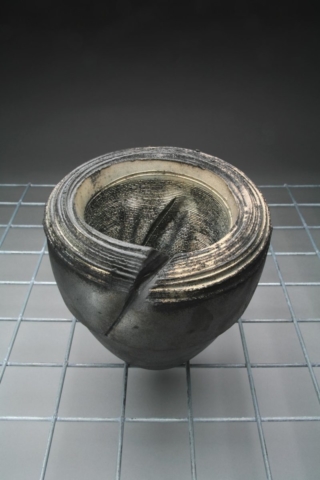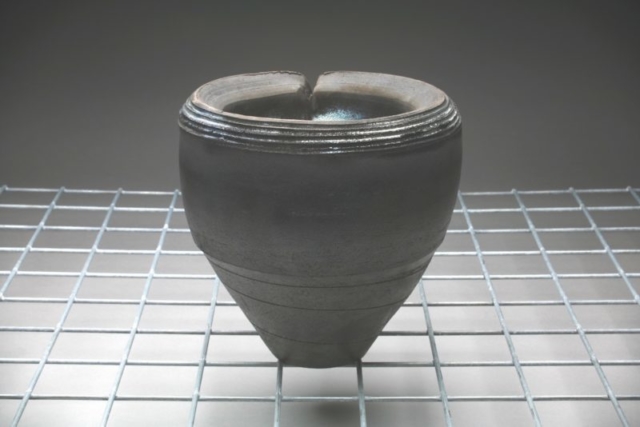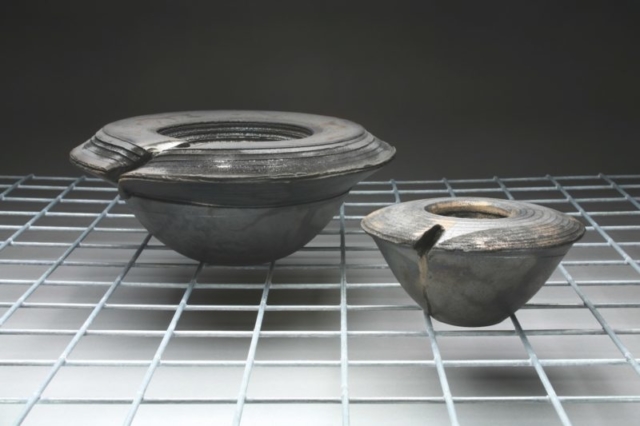Vessels about containment
- Artefacts created for the Exhibition: Raku – Origins, Impact and Contemporary Expression. International Raku Symposium, Eagleheart center for Art and Inquiry, Grand Junction, Colorado, USA; and Exhibition Tour (co-curated), USA, 2005 – 2007.
- 2006 American Museum of Contemporary Art, Pomona California, USA
- 2006 RC Gallery, Portland, Oregan, USA. [For NCECA].
- 2007 Ceramics Research Center Gallery, Arizona State University Museum, USA
- Other exhibitors included: Toshio Ohi, Paul Soldner (the originator of American raku and the author of the article that first alerted us to the possibilities of the practice), Richard Hirsch (who had written Raku – the first significant book on the practice), Tim Andrews (who had written the first major book on raku in the UK), Jean Biagini (who was one of the earliest European exponents of raku).
This body of work is concerned with the creation of a vocabulary, of form and surface, through contrast. The pieces reference bowls, the archetypal form of ceramics. They are about containment, both in the volume of trapped air in the double wall and the shallow depression that could hold. The architecture of the bowl is confronted to generate a grammar of shape. The inside is related and contrasted to the outside profile. Free marking on the interior, gouged with rough tools; a machined finish on the outer skin, all reflecting the range of texture made possible with the rotating potter’s wheel. Between these two surfaces lies the rim, which is also seriously considered, as the significant interface between the outer and inner realities.
This treatment focuses on the softness, the pliability and the way in which clay can take up an imprint and be manipulated when plastic. In this way it recapitulates its own geological history – from mud to rock. The work takes as its influences the vessels of the Japanese Tea Ceremony – in particular the Tea Bowl. This is further informed by my own take on the references of the Japanese masters – the impressions and markings of nature: from the erosion of a sea-side rock-pool, revisiting the concentric markings left by the abrasions of the sea, to the systematic dragging of a plough across the countryside. The relationship of the ceramics to the human body is very significant, both in terms of the scale of the work and in the idea of skin and the intimate marks found in the crumpling of flesh.
The work is made by using a porcelain clay mixed with molochite, because it is so responsive as a register of these traces. It is Raku fired, the pots removed red-hot from the kiln and either buried or fumed in sawdust to allow varying degrees of penetration and marking by carbon, giving a product that is soft and warm to the touch.
![Font. [David Jones].63x29cms. Raku Fired ceramics red for Phd](http://www.davidjonesceramics.com/wp-content/uploads/2020/07/Font.-David-Jones.63x29cms.-Raku-Fired-ceramics-red-for-Phd-640x480.jpg)
![scylla and charibdis 28x34cms. Raku-fired ceramics [david jones]](http://www.davidjonesceramics.com/wp-content/uploads/2020/07/scylla-and-charibdis-28x34cms.-Raku-fired-ceramics-david-jones-640x480.jpg)
![Winter Lake. 28×16 cms. Raku fired ceramics [David Jones]](http://www.davidjonesceramics.com/wp-content/uploads/2020/07/Winter-Lake.-28x16-cms.-Raku-fired-ceramics-David-Jones-800x523-640x480.jpg)
![white void. 23x16cms. Porcelain [david jones]](http://www.davidjonesceramics.com/wp-content/uploads/2020/07/white-void.-23x16cms.-Porcelain-david-jones-640x480.jpg)
![dark pool. 44×19 cms. Raku firedceramics. [david jones]](http://www.davidjonesceramics.com/wp-content/uploads/2020/07/dark-pool.-44x19-cms.-Raku-firedceramics.-david-jones-800x553-640x480.jpg)


